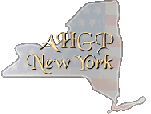|
 |
New York AHGP
Part of the American
History & Genealogy Project |
First Settlement & Settlers of Franklin County

The first settlement within the present
bounds of the county was made at St. Regis by a colony
of Indians* from Caughnawaga, under Father Anthony Gordon, a
Jesuit, in about the year 1760.
The first white settlement was made in
the town of Chateaugay, in 1796, by Benjamin Roberts,
of Ferrisburgh, Vermont, and Nathan Beman, of Plattsburgh. The
latter was the youth who piloted Ethan Allen into the fort at
Ticonderoga on that morning when its surrender was demanded in
the name of the "Great Jehovah and the Continental Congress."
Other early settlers in Chateaugay
were John Allen, Samuel Haight, Lewis Ransom, etc.
Settlements in Bangor were made
as early as 1806 by Benjamin Seeley, originally from Vermont,
but who for several years had resided in Moira, and Joseph
Plumb, originally from Middlebury, Vermont. Jehial and James
Barnum were also early settlers in this town.
The first settlement of Belmont
was made at a comparatively recent period. Among the first
settlers were the Drew family, Ashley Collins, Apollos, Wrig,
John Richey, and John Orcutt.
The first settlements in Bombay*
were made prior to 1812. Among the pioneers were Wm. Gray, the
Indian interpreter, Wm. Hogan, Joseph Hudley, James Luther,
Jesse Clark, etc.
Settlement in Brandon commenced
in 1820. The pioneers were Josiah Hastings, Aaron Conger, Wilson
Spencer, Luther Taylor, and John Thomas.
Burke was among the first towns
settled in the county. To Jehial Barnum is ascribed the honor of
having been the first settler, in about 1797. He was soon
followed by Noah Lee, John Allen, Azon Hawks, and Gilbert
Reynolds.
The pioneers of Constable were
Jonathan Hapgord and Christopher Austin, who came from Milton,
Vermont, and located in the northern part of the town, on Trout
River, in the year 1800.
The first settlement in the town of
Dickinson was made by Jesse D. and Jonathan Rice, who came
from Vermont, and located on what is now known as the St.
Lawrence Turnpike, in about the year 1800. Reuben Cady, Homer
Wood, and Samuel Foster were also pioneers.
The first settlement in Duane
was made by James Duane in 1825: The title to a large portion of
the town was acquired by James Duane in 1821 He commenced
improvements and erected a dwelling in 1823 or '24.
Among the pioneers of Fort Covington
were James and Alexander Robertson, Samuel Fletcher, Aaron
McLean, Ambrose Cushman, John Hunsden, David Lynch, Robert
Nutter, and Duncan Buchanan.
The first settlement in Franklin
was begun by the erection of a forge and saw-mill by McLenathen
& Wells, of Jay, Essex Co., in about the year 1827. This
settlement was made at Franklin Falls, then known as McLenathen
Falls.
Harrietstown was settled prior
to 1812 by inhabitants from the adjoining counties, who located
on the Northwest Bay road. One of the first settlers was Pliny
Miller.
The pioneers of Malone were
Enos, Nathan, and John Wood, who came from St. Albans, Vermont,
and located in 1802. They were soon after followed by Luther
Winslow, Newell Conger, Jehial Berry, Noah Moody, Roswell
Wilcox, and David and Lyman Sperry.
The first settlement in Moira
was made in 1803 by Appleton Foote, agent for Gilchrist &
Fowler, the proprietor of the town. Other prominent pioneers
were Jonathan Lawrence and Joseph Plumb. The latter subsequently
located in Bangor.
Amos Welch, from Grand Isle, Vermont,
and _____ Harkins, Elisha Sabins, Samuel Fletcher, John Reed,
Alexander McMillan, Silas Cushman, John Livingstone, Jos. and
Thos. Wright, and Alric and De Albon Man, mostly from Vermont,
located here in about the year 1803.
Footnote:
* See History of Bombay.
Clinton County| AHGP New York

|